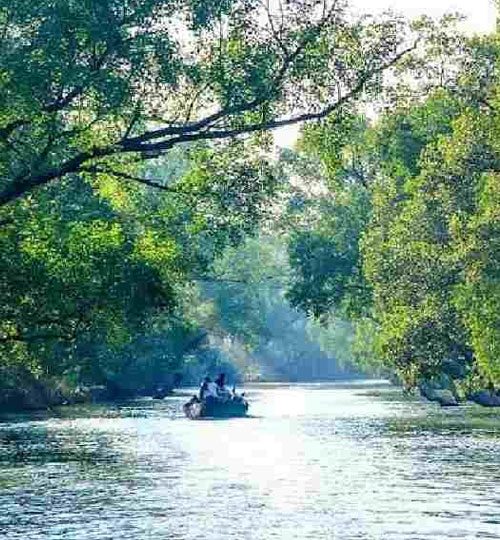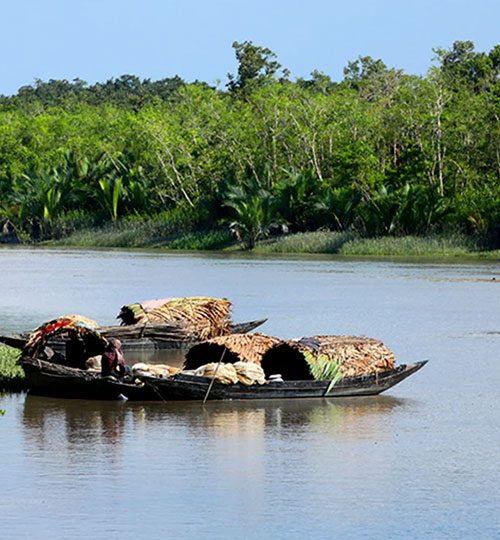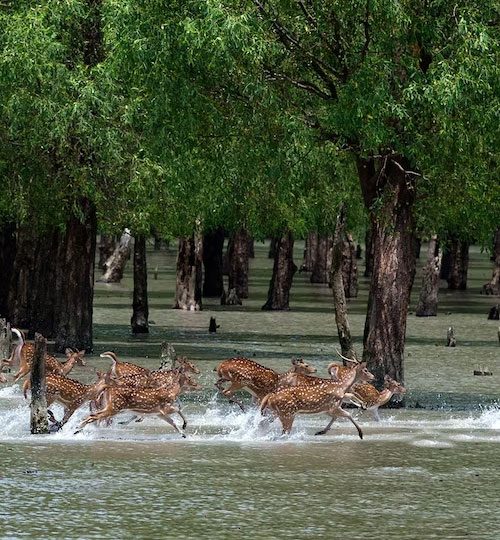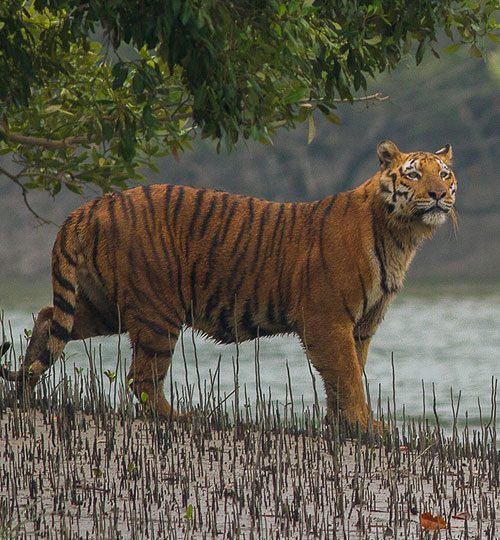Sundarbans
This is one of the most unique, attractive and undiscovered places on earth. The Sundarbans is the world’s largest coastal mangrove forest covering regions of Bangladesh and the Indian state of West Bengal. Sundarban National Park is a Tiger reserve and one of the major attractions in West Bengal and it is a continuation of the Sundarban forest of Bangladesh. It is part of the world’s largest delta.
The Sundarbans is situated at the lower end of Gangetic West Bengal and contains the districts of North and South 24 Parganas. The Sundarban delta region is formed by great rivers like the Ganges, Brahmaputra and Meghna. Sundarban is home to one of the most attractive and famous wildlife species, the Royal Bengal Tiger. No National Park in India can match the mystery and uniqueness of the Sundarbans. It is declared a World Heritage Site by UNESCO.
Flora and Fauna
Sundarbans is famous as the home of the majestic Royal Bengal Tigers, the main attraction of the forest. Besides, a large variety of wildlife including a large number of different species of Deer, Wild boar, Fishing and jungle cats, leopard cats, Monkeys, and Indian grey mongoose is very common here. Sundarbans are also the home of one of the most dangerous predators – the Saltwater crocodiles. Verities of snakes, Turtles, and monitor lizards are also common inhabitants of the region. Sundarbans is also a bird watchers' paradise. It is a mangrove forest with different species of mangrove trees. It is said that Sundarban derived its name from a large number of Sundari trees found in the delta.




Places of Interest
Sajnekhali Watchtower
This is the most popular watchtower in Sundarbans. Located on Sajnekhali island, this watchtower can accommodate 20 people together in the tower at a time. It is an ideal place to have a good look at the surrounding forests. People can visit the Bono Bibi (The principal deity of the Sundarbans region) temple here. This area also has a Crocodile park. The head office of the forest department is located here. There is a bird sanctuary on Sajnekhali Island. It is an ideal place for bird watchers.
Sudhanyakhali Watch Tower
One of the best locations to spot wildlife including the evasive tiger. Very popular among tourists. Sudhanyakhali Watch Tower can accommodate 25 people at a time. There is a sweet water pond here where animals come to drink. The surrounding view is exquisite from this tower.
Do Banki Watch Tower
It has become popular among tourists. Deers are often sighted here. The surrounding landscape is beautiful. There is a specific feature of Do Banki, tourists can enjoy wildlife through a canopy walk. The elevation of the canopy is 20 feet from the ground and it stretches half a kilometre.
Bhagabatpur Crocodile Project
Sundarban is home to a large number of saltwater crocodiles. This crocodile breeding farm provides an opportunity for travellers to see the crocodiles and the conservation process they go through.
Netidhopani
An important point in the Sundarbans tour. This watchtower can accommodate 20 people at a time. Apart from the forest and wildlife, the place is also popular for a 400-year-old Shiva temple.
Kalash Island
It is the breeding ground of the Olive Ridley Turtle. Although it is part of Sundarban National Park, this island is situated beyond the core area. Still largely undiscovered, this island is full of natural beauty and mystery.
Mode of Travel
Sundarban is crisscrossed by several rivers, creeks, and tributaries. This is the only national park in the country where jeep safari or other types of safari is not possible. Travellers visiting Sundarban have to sail through the river in a boat. These boats or vassal rides are an everlasting experience. Not only one sees wildlife but also the social life of the inhabitants of the local villages of the area can be observed. The boat tours may be a day tour, there are several boats with rooms for overnight accommodation which are often used for multiple-day tours.
Best Time to visit
Sundarbans can be visited at any time of the year, but the monsoon months are not highly recommended. Between mid-June to the middle of September, this area receives heavy rainfall. April and May are good times to visit, except the weather can be quite hot and humid here. However, the chances of wildlife sightings are better. October to March is considered high season here. The weather is pleasant during this period. Sundarbans being on the Gangetic delta and the coastal region of the Bay of Bengal, the area sometimes experiences heavy storms and cyclones during monsoon and summer.
Getting There
To get into the Sundarbans, you have to take a boat, the boat ride starts from Gadkhali or Sonakhali. Gadkhali is a better option as it is closer to the forests. If you are starting from Sonakhali you will require an additional hour for your boat to reach the Gadkhali area.
From Gadkhali, most boats take a small canal through Gosaba Island, about half an hour’s ride on the boat will take you across the Gosaba area and to the Datta River, across the river is the forests of Sundarbans.
The ferry ghats of Sundarban are well connected through Road and Rail with Kolkata. The nearest Rail station is Canning, from here the Sonakhali boating point is 18 km away, and Godkhali is 12 km further. Canning has trains to local trains connecting to Sealdah station of Kolkata almost on an hourly basis.
If you are travelling by road, there are multiple roads connecting Gadkhali with Kolkata. The most popular route is to travel by Malancha Highway (Also known as Basanti Highway) which originates at Bantala in Kolkata. The distance through the route is about 84 km. Alternatively, you may travel through Baruipur on the outskirts of Kolkata. This route is about 80 km long.
